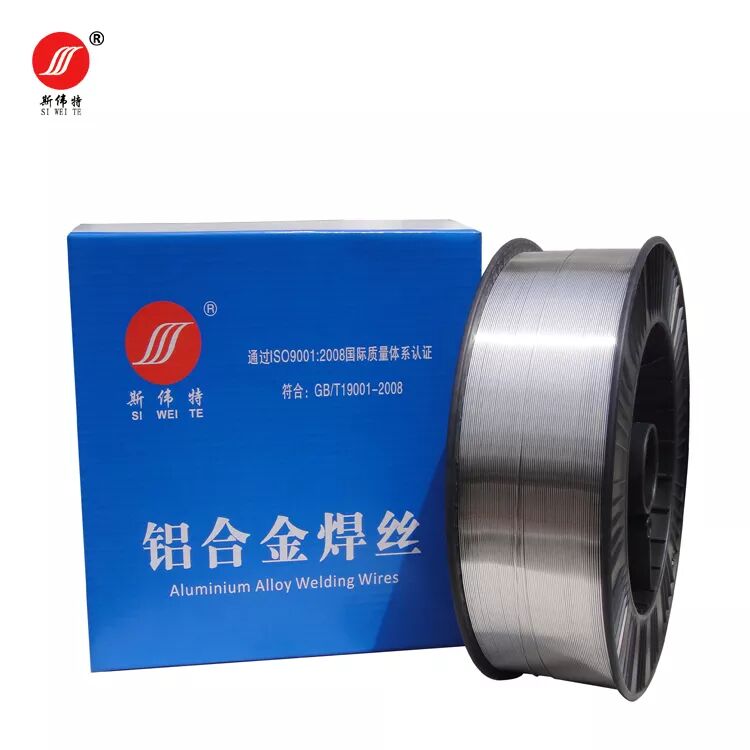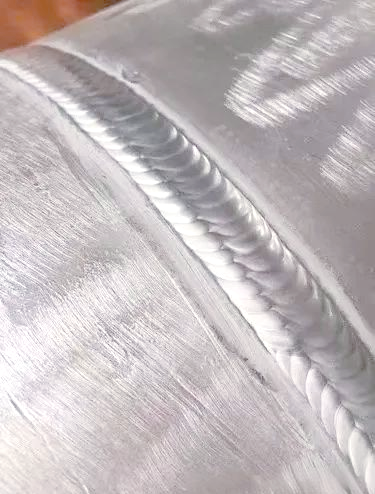MIG welding is the most popular choice for aluminum fabrication—its ease of use, speed, and versatility make it ideal for both beginners and pros. But MIG aluminum welding comes with unique challenges: soft wire, high thermal conductivity, and oxidation can lead to spatter, burn-through, or weak welds. As a trusted aluminum welding wire manufacturer, we’ve compiled this comprehensive guide to MIG aluminum welding setup, pro tips, and critical safety precautions—tailored to help you achieve clean, strong welds every time.
Whether you’re working on thin aluminum sheets (1.0mm) or thick structural parts, these insights will help you master the MIG process while staying safe. Let’s dive in!
Why MIG Welding Is Ideal for Aluminum
Before we get to setup and tips, let’s break down why MIG is the go-to for aluminum:
- High deposition rate: MIG welding lays down weld metal faster than TIG, making it perfect for large projects or 批量生产.
- Forgiving for beginners: The continuous wire feed and stable arc are easier to control than TIG’s manual filler wire addition.
- Versatile: Works with all common aluminum grades (6061, 5052, 6063) and thicknesses (1.0mm–10mm+), from hobby builds to industrial applications.
But MIG aluminum welding isn’t without quirks—aluminum’s softness and rapid heat dissipation require specific setup and technique adjustments. Let’s cover the essentials.
Essential MIG Aluminum Welding Setup
The right setup is make-or-break for MIG aluminum welding. Follow these steps to avoid common issues like wire jamming, porosity, or burn-through.
1. Choose the Right Equipment
- MIG Welder: Opt for a welder with adjustable voltage, amperage, and wire feed speed (100–250A range works for most aluminum projects). Look for pulse mode if possible—this controls heat input, critical for thin aluminum.
- Spool Gun: A must-have for MIG aluminum welding. Aluminum wire is soft and prone to kinking in standard feeding hoses; a spool gun mounts the wire spool directly on the gun, eliminating feeding issues.
- Shielding Gas: Use 100% argon (never mix with CO₂—this causes contamination). Set flow rate to 20–25 CFH (cubic feet per hour) to protect the weld pool from oxidation.
- Contact Tips: Choose chromium-zirconium copper (Cr-Zr-Cu) tips matching your wire diameter (0.8mm, 1.0mm, or 1.2mm). Cr-Zr-Cu tips are more 耐磨 than brass, reducing replacement frequency.
2. Select the Best Aluminum Welding Wire
For MIG aluminum welding, two wire grades dominate—choose based on your project:
- 4043 Aluminum Wire: Ideal for general-purpose welding (6061, 6063 aluminum, thin sheets, DIY projects). It has excellent fluidity, less spatter, and is forgiving for beginners.
- 5356 Aluminum Wire: Better for high-strength or marine applications (5052, 5083 aluminum). It offers superior corrosion resistance but requires more precise heat control.
Stick with 0.8mm or 1.0mm diameter wire for thin aluminum (≤3mm) and 1.2mm for thicker material (≥4mm). Our 4043 and 5356 wires are engineered for smooth feeding and minimal defects—perfect for MIG setups.
3. Dial In the Correct Settings
Use these as starting points (adjust based on your welder, wire diameter, and material thickness):
| Aluminum Thickness | Amperage (A) | Voltage (V) | Wire Feed Speed (ipm) | Gas Flow (CFH) |
|---|---|---|---|---|
| 1.0mm–1.5mm | 80–120 | 18–22 | 150–220 | 20–22 |
| 2.0mm–3.0mm | 120–160 | 22–24 | 220–300 | 22–24 |
| 4.0mm–6.0mm | 160–220 | 24–27 | 300–380 | 24–25 |
- Pulse Mode: Enable if your welder has it for thin aluminum. Pulse mode alternates between high and low current, reducing average heat input and preventing burn-through.
- Test on Scrap: Always adjust settings on a piece of scrap aluminum before welding your project. Look for a smooth arc, consistent bead, and minimal spatter.
Pro Tips for Perfect MIG Aluminum Welding
Even with the right setup, technique makes all the difference. These pro tips will help you avoid common MIG aluminum welding mistakes.
1. Prep the Aluminum Thoroughly
Aluminum’s oxide layer (Al₂O₃) is the #1 enemy of clean welds. It melts at 3,700°F—far higher than aluminum’s 1,200°F melting point—so it must be removed:
- Scrub the joint and 1–2 inches around it with a stainless steel brush (one-way strokes to avoid spreading debris).
- Wipe with acetone to remove oil, grease, or remaining oxide.
- Weld immediately—aluminum reoxidizes in minutes!
2. Master the Gun Angle & Distance
- Push Angle: Hold the MIG gun at a 10–15° push angle (push the weld pool forward). This breaks up the oxide layer and improves fusion—critical for MIG aluminum welding.
- Gun Distance: Keep the contact tip 1/4–3/8 inch from the workpiece. Too close causes spatter; too far leads to porosity (air contamination).
3. Control Heat & Travel Speed
- Avoid Overheating: Aluminum conducts heat 5x faster than steel. Use a fast travel speed (consistent, not rushed) to prevent burn-through on thin sheets.
- Stitch Welding for Thick Aluminum: For material ≥4mm, weld 1–2 inch segments, let cool, then continue. This reduces warping and heat buildup.
4. Prevent Wire Feeding Issues
- Keep the spool gun cable straight—kinks cause wire jamming.
- Clean the wire feeder rollers regularly (aluminum shavings can build up and disrupt feeding).
- Tighten the contact tip with pliers (not just your hand)—loose tips cause arc instability and premature wear.
Critical MIG Aluminum Welding Safety Precautions
MIG aluminum welding has unique safety risks—here’s how to protect yourself and your workspace (focused on MIG-specific hazards):
1. PPE for MIG Aluminum Welding
- Auto-Darkening Helmet: Use shade 10–13 (aluminum’s bright arc needs darker shading than steel). Ensure full face coverage to block sparks and UV radiation.
- Leather Gloves & Jacket: MIG welding produces more spatter than TIG—thick leather gloves and a flame-resistant jacket prevent burns.
- Respirator: MIG’s higher deposition rate means more aluminum oxide fumes. Wear an N95/N99 respirator, especially in indoor workshops.
- Steel-Toed Boots: Protect against falling hot metal or tools.
2. Workspace Safety
- Ventilation: Use exhaust fans or open windows to clear fumes. MIG aluminum welding produces more 烟尘 than TIG—poor ventilation leads to respiratory issues.
- Fire Safety: Keep a Class D fire extinguisher (for metal fires) within reach. MIG spatter can ignite flammable materials (rags, oil) from 10+ feet away.
- Gas Tank Safety: Secure argon tanks upright with a chain. Check hoses for leaks (use soapy water—bubbles indicate leaks) before use.
3. MIG-Specific Hazards to Avoid
- Wire Jamming: Never force the wire if it jams—this can damage the feeder or gun. Stop welding, cut the wire, and clear the blockage.
- Overheated Gun: MIG guns (even spool guns) can overheat during long welds. Pause every 5–10 minutes to let the gun cool—overheating damages the motor and contact tip.
- Electric Shock: Aluminum is a good conductor. Keep the welder grounded, and avoid touching the contact tip or hot metal with wet hands.
Troubleshooting Common MIG Aluminum Welding Issues
Even pros run into problems—here’s how to fix the most frequent MIG aluminum welding issues:
1. Porosity (Tiny Holes in Weld)
- Causes: Dirty aluminum, insufficient gas flow, or gun distance too far.
- Fix: Clean the workpiece thoroughly, increase gas flow to 22–25 CFH, and keep the gun tip 1/4 inch from the metal.
2. Spatter
- Causes: Voltage too high, wire feed speed too fast, or dirty contact tip.
- Fix: Lower voltage by 1–2V, reduce wire feed speed, and replace worn contact tips.
3. Burn-Through
- Causes: Too much heat, travel speed too slow, or thin material without pulse mode.
- Fix: Lower amperage by 20–30A, increase travel speed, or enable pulse mode.
4. Lack of Fusion
- Causes: Voltage too low, travel speed too fast, or poor joint prep.
- Fix: Increase voltage by 1–2V, slow travel speed, and ensure the oxide layer is fully removed.
Conclusion: Master MIG Aluminum Welding with the Right Setup & Tips
MIG aluminum welding doesn’t have to be frustrating—with the right equipment, precise setup, and pro techniques, you’ll consistently produce clean, strong welds. Remember to prioritize preparation (clean aluminum is non-negotiable), dial in your settings, and follow MIG-specific safety precautions to avoid hazards.
As an aluminum welding wire manufacturer, our 4043 and 5356 wires are designed to work seamlessly with MIG setups—reducing spatter, improving feeding, and ensuring consistent results. Whether you’re a beginner or a seasoned pro, the right wire makes all the difference.
Explore our MIG aluminum welding wire range today, and take your MIG aluminum welding skills to the next level. For more personalized tips, contact our team of welding experts—we’re here to help you succeed!




